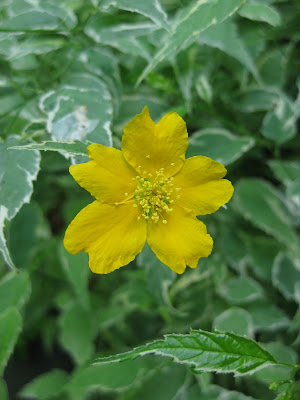I awoke to another 1" of fluffy snow on the ground this morning which wasn't much to shovel but enough to make the roads a bit slick this morning. It turned out to be a nice sunny day for the most part though with the roads clearing quite quickly. We had a busy day around the Horticulture Center with many volunteers coming and going. Dr. Gredler did more painting and Pat continued work on his projects. Larry continued making another batch of concrete bases for our tree and shrub labels while Bill O. helped with various projects including some snow removal. Dick H. came in to do some touch up plowing with his truck/plow and Bev D. popped in to talk about some upcoming spring activities including our garden art project (suns). Gary worked on some new labels and later joined our Garden Development & Maintenance Committee Meeting which also included Rose, Big John, Christine, Joanne, Maury and Larry H. We talked about many of our spring initiatives and 2013 plans/priorities. Maury later ran some errands for us (thanks Maury!) and we saw Chuck S. later in the day for recycling. I'm almost done with spring orders, presentation preparation and other duties as I get more involved with looming special events (compost sale, tree sale, Spring Plant Sale, etc.), all of which are on our website.
'Golden Guinea' (above and below)
All the images in this blog feature varieties of Japanese kerria (Kerria japonica) which is also called Japanese rose. Native to parts of China and Japan, this member of the rose family is a strong spring bloomer with typically five-petaled, single or double yellow blossoms. There are some white (cream) bloomers too but I prefer the yellow for bright color in late April through mid May. A member of the Rosaceae family, kerria is adaptable to a wide range of soils although it doesn't care for clay. Kerrias will also tolerate sun, part sun and full shade. However, part sun is ideal as the flowers don't fade, have maximum longevity and the serrated foliage stays fresh. Our best specimens are in part shade. In full shade, kerrias will grow but not flower strongly With serrated leaves that turn golden in fall, this shrub also features green stems which I consider marginally interesting in winter (see further below). It is important to note that kerria is considered a "thicketing shrub" in that it does send up new stalks and continue to widen with age. Prune kerrias in spring after they are done blooming as they bloom on old wood (similar to a lilac). With a mature height (in our area) of about 5' tall, the plants will keep spreading moderately to 8'-10'. Some spring digging work can keep the "real estate" under control for these shrubs. Kerria naturally arches over and has a nice, informal look, particularly when in bloom. Some varieties are chosen for blooms like the single-flowering 'Golden Guinea' both above and directly below. The double-flowering variety 'Pleniflora' or 'Flore Pleno' is top notch too (see further below). Both 'Golden Guinea' and 'Pleniflora' received the Royal Horticultural Society's (RHS) Award of Garden Merit which says a lot about their value. 'Chiba Gold' has golden foliage while 'Picta' has a nice white variegation. All green leaf varieties will get some decent yellow fall color in mid-October in to early November. Both 'Shannon' and 'Honshu' are noted for extremely large blooms and the novelty variety 'Kin Kan' has green and yellow striped stems (doesn't impress me as a feature). What I like best about kerrias is their low maintenance and significant flower power in spring. These images, identified beneath the photo, lend value to the statement that kerrias are durable spring bloomers that perform best in part shade where their informal habit can be appreciated.
'Pleniflora'
'Shannon'
Kerria japonica fall color
Kerria japonica fall color
Kerria japonica fall color
Kerria japonica stems
'Pleniflora'
'Pleniflora' close-up
'Chiba Gold'
'Chiba Gold'
'Chiba Gold' flower close-up
'Picta' (natural habit)
'Picta' (lightly trimmed)
'Picta' blooms
'Picta' flower close-up
'Picta'



.JPG)


.jpg)



+at+peak.jpg)
.jpg)
+closeup.jpg)
.jpg)
.jpg)
+closeup.jpg)
.JPG)



.JPG)

No comments:
Post a Comment